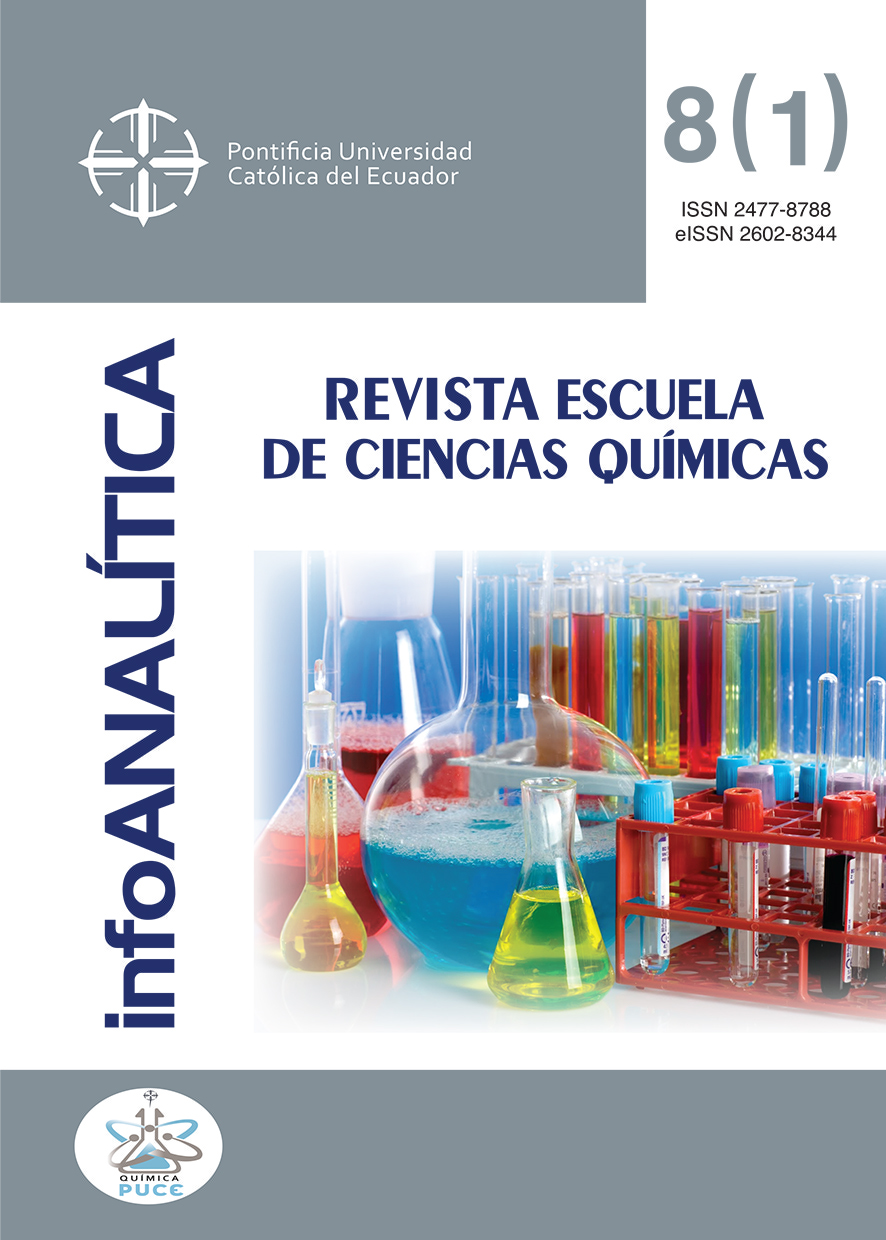SYNTHESIS AND CHARACTERIZATION OF COMPOSITES BASED ON HALLOYSITE AND BISMUTH NANOESTRUCTURES
Main Article Content
Abstract
In this work, nanocomposites based on halloysite nanotubes have been synthesized and characterized. Halloysite is a phyllosilicate with multilayer nanotubular structure. Halloysite nanotubes are a low-cost alternative with similar morphology over carbon nanotubes. In addition, the tubular structure is combined with differences in reactivity between the external surface and internal surface. The nanocomposites were synthesized by the impregnation of precursors over halloysite nanotube surface, after that nanoparticle growth was done in situ. The characterization of the nanocomposites included several spectroscopic techniques such as electronic absorption spectroscopy (UV-Vis). Also, X-ray diffraction was used for structure characterization. The morphology of the nanocomposites was study with scanning electron microscopy (SEM) and transmission electron microscopy (TEM). In addition, energy dispersive spectroscopy (EDS) was used in order to determine composition and identify distribution of elements over halloysite. The results indicated that Bi2S3 nanoparticles (Bi2S3 NPs) were successfully deposited on the surface of halloysite nanotubes (HNTs). Bi2S3 nanoparticles synthesized over halloysite surface have a greater diameter than particles synthesized without HNTs as a support; reduction in the peak wide of diffraction patterns and decrement in the bandgap energy value. The development of these nanocomposites account to maintain nanoparticles dispersed all over halloysite and avoiding particle agglomeration. Lastly, halloysite nanotubes contribute to maintain size control and a narrow size distribution of nanoparticles.
Downloads
Article Details
- The authors agree to respect the academic information of other authors, and to assign the copyrights to the journal infoANALÍTICA, so that the article can be edited, published and distributed.
- The content of the scientific articles and the publications that appear in the journal is the exclusive responsibility of their authors. The distribution of the articles published in the infoANALÍTICA Journal is done under a Creative Commons Reconocimiento-CompartirIgual 4.0 Internacional License.
References
Biswas, K., Zhao, L.-D., & Kanatzidis, M. G. (2012). Tellurium-Free Thermoelectric: The
Anisotropic n-Type Semiconductor Bi2S3. Advanced Energy Materials, 2(6), 634–
638. https://doi.org/10.1002/aenm.201100775
Brahimi, R., Bessekhouad, Y., Bouguelia, A., & Trari, M. (2007). Visible light induced hydrogen
evolution over the heterosystem Bi2S3/TiO2. Catalysis Today, 122(1), 62–
65. https://doi.org/https://doi.org/10.1016/j.cattod.2007.01.030
Cademartiri, L., Scotognella, F., O’Brien, P. G., Lotsch, B. V, Thomson, J., Petrov, S., …
Ozin, G. A. (2009). Cross-Linking Bi2S3 Ultrathin Nanowires: A Platform for
Nanostructure Formation and Biomolecule Detection. Nano Letters, 9(4), 1482–
1486. https://doi.org/10.1021/nl803417v
Cao, J., Xu, B., Lin, H., Luo, B., & Chen, S. (2012). Novel Bi2S3-sensitized BiOCl with
highly visible light photocatalytic activity for the removal of rhodamine B. Catalysis
Communications, 26(Supplement C), 204–208. https://doi.org/https://doi.org/10.
1016/j.catcom.2012.05.025
Du, M., Guo, B., & Jia, D. (2010). Newly emerging applications of halloysite nanotubes:
A review. Polymer International. https://doi.org/10.1002/pi.2754
Hendricks, S. (1938). Crystal Structures of the Clay Mineral Hydrates. Nature, 142, 38.
doi:10.1038/142038a0
Konstantatos, G., Levina, L., Tang, J., & Sargent, E. H. (2008). Sensitive Solution-
Processed Bi2S3 Nanocrystalline Photodetectors. Nano Letters, 8(11), 4002–4006.
https://doi.org/10.1021/nl802600z
Liu, M., Jia, Z., Jia, D., & Zhou, C. (2014). Recent advance in research on halloysite nanotubes-
polymer nanocomposite. Progress in Polymer Science, 39(8), 1498–1525.
https://doi.org/https://doi.org/10.1016/j.progpolymsci.2014.04.004
Lvov, Y., Wang, W., Zhang, L., & Fakhrullin, R. (2016). Halloysite Clay Nanotubes for
Loading and Sustained Release of Functional Compounds. Advanced Materials,
28(6), 1227–1250. https://doi.org/10.1002/adma.201502341
Ortiz, J. L., Vega, C., Díaz, D., & Zumeta, I. (2018). Transformation of Bismuth and β-
Bi2O3 Nanoparticles into (BiO)2CO3 and (BiO)4(OH)2CO3 by Capturing CO2:
The Role of Halloysite Nanotubes and “Sunlight” on the Crystal Shape and Size.
Crystal Growth & Design, 18(8), 4334–4346. https://doi.org/10.1021/acs.
cgd.8b00177
Papoulis, D., Komarneni, S., Nikolopoulou, A., Tsolis-Katagas, P., Panagiotaras, D., Kacandes,
H. G.,Katsuki, H. (2010). Palygorskite- and Halloysite-TiO2 nanocomposites:
Synthesis and photocatalytic activity. Applied Clay Science, 50(1), 118–124.
https://doi.org/https://doi.org/10.1016/j.clay.2010.07.013
Pejova, B., & Grozdanov, I. (2006). Structural and optical properties of chemically deposited
thin films of quantum-sized bismuth(III) sulfide. Materials Chemistry and
Physics, 99(1), 39–49. https://doi.org/10.1016/j.matchemphys.2005.10.010
Singh, B. (1996). Why Does Halloysite Roll?—A New Model. Clays and Clay Minerals,
44(2), 191–196. https://doi.org/10.1346/CCMN.1996.0440204
Tang, X., Li, L., Shen, B., & Wang, C. (2013). Halloysite-nanotubes supported FeNi alloy
nanoparticles for catalytic decomposition of toxic phosphine gas into yellow phosphorus
and hydrogen. Chemosphere, 91(9), 1368–1373. https://doi.org/https://doi.
org/10.1016/j.chemosphere.2013.02.010
Vogel, R., Hoyer, P., & Weller, H. (1994). Quantum-Sized PbS, CdS, Ag2S, Sb2S3, and
Bi2S3 Particles as Sensitizers for Various Nanoporous Wide-Bandgap Semiconductors.
The Journal of Physical Chemistry, 98(12), 3183–3188. https://doi.org/10.
1021/j100063a022
Wu, T., Zhou, X., Zhang, H., & Zhong, X. (2010). Bi2S3 nanostructures: A new photocatalyst.
Nano Research, 3(5), 379–386. https://doi.org/10.1007/s12274-010-
1042-0
Xi, Y., Hu, C., Zhang, X., Zhang, Y., & Wang, Z. L. (2009). Optical switches based on
Bi2S3 nanowires synthesized by molten salt solvent method. Solid State Communications,
149(43), 1894–1896. https://doi.org/https://doi.org/10.1016/j.ssc.2009.
08.003
Xing, G., Feng, Z., Chen, G., Yao, W., & Song, X. (2003). Preparation of different morphologies
of nanostructured bismuth sulfide with different methods. Materials Letters,
57(29), 4555–4559. https://doi.org/https://doi.org/10.1016/S0167-577X
(03)00361-6
Yao, K., Gong, W. W., Hu, Y. F., Liang, X. L., Chen, Q., & Peng, L.-M. (2008). Individual
Bi2S3 Nanowire-Based Room-Temperature H2 Sensor. The Journal of Physical
Chemistry C, 112(23), 8721–8724. https://doi.org/10.1021/jp8022293
Zhang, Y., Chen, Y., Zhang, H., Zhang, B., & Liu, J. (2013). Potent antibacterial activity
of a novel silver nanoparticle-halloysite nanotube nanocomposite powder. Journal
of Inorganic Biochemistry, 118(Supplement C), 59–64. https://doi.org/https://doi.
org/10.1016/j.jinorgbio.2012.07.025
Zumeta, I., Ortiz, J. L., Díaz, D., Trallero, C., & Ruiz, V. F. (2014). First order raman scattering
in bulk Bi2S3 and quantum dots: Reconsidering controversial interpretations.
Journal of Physical Chemistry C, 118(51), 30244–30252.
https://doi.org/10.1021/jp509636n

